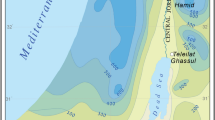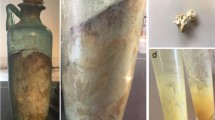Abstract
The olive tree was an iconic plant for most of the past Mediterranean civilizations, for which it had important economic value. Here we report the earliest use of fruits and wood from olive trees in Africa so far, around 100,000 years ago. These findings suggest the presence of olive trees on the Atlantic coast of Morocco during most of the last glacial period, and the use of olives by the early Homo sapiens for fuel management and most probably for consumption.
This is a preview of subscription content, access via your institution
Access options
Access Nature and 54 other Nature Portfolio journals
Get Nature+, our best-value online-access subscription
$29.99 / 30 days
cancel any time
Subscribe to this journal
Receive 12 digital issues and online access to articles
$119.00 per year
only $9.92 per issue
Buy this article
- Purchase on Springer Link
- Instant access to full article PDF
Prices may be subject to local taxes which are calculated during checkout


Similar content being viewed by others
Data availability
All data used in the main text and Supplementary Information are available in Supplementary Data 1. The material is housed at the Department of Botany of the University of Innsbruck, Austria. The Olea pollen data from three marine sedimentary cores (Supplementary Text 14) are available via PANGAEA at https://doi.org/10.1594/PANGAEA.55037 (A4-M15627-3), https://doi.org/10.1594/PANGAEA.55039 (A3-M16004-1) and https://doi.org/10.1594/PANGAEA.55038 (A2-M15669-1).
References
Goren-Inbar, N. et al. Evidence of hominin control of fire at Gesher Benot Ya’aqov, Israel. Science 304, 725–727 (2004).
Liphschitz, Gophna, R., Hartman, M. & Biger, G. The beginning of olive (Olea europaea) cultivation in the Old World: a reassessment. J. Archaeol. Sci. 18, 441–453 (1991).
Jennings, R. P. et al. New dates and palaeoenvironmental evidence for the Middle to Upper Palaeolithic occupation of Higueral de Valleja Cave, southern Spain. Quat. Sci. Rev. 28, 830–839 (2009).
Carrión, Y., Ntinou, M. & Badal, E. Olea europaea L. in the North Mediterranean Basin during the Pleniglacial and the early–middle Holocene. Quat. Sci. Rev. 29, 952–968 (2010).
Kuhn, S. L. et al. Radiocarbon dating results for the early Upper Paleolithic of Klissoura Cave 1. Eurasian Prehistory 7, 37–46 (2010).
Kislev, M. E., Nadel, D. & Carmi, I. Epipalaeolithic (19,000 BP) cereal and fruit diet at Ohalo II, Sea of Galilee, Israel. Rev. Palaeobot. Palynol. 73, 161–166 (1992).
Terral, J. F. Exploitation and management of the olive tree during prehistoric times in Mediterranean France and Spain. J. Archaeol. Sci. 27, 127–133 (2000).
Terral, J. F. et al. Historical biogeography of olive domestication (Olea europaea L.) as revealed by geometrical morphometry applied to biological and archaeological material. J. Biogeogr. 31, 63–77 (2004).
Zohary, D. & Spiegel-Roy, P. Beginnings of fruit growing in the Old World. Science 187, 319–327 (1975).
Besnard, G. et al. The complex history of the olive tree: from Late Quaternary diversification of Mediterranean lineages to primary domestication in the northern Levant. Proc. R. Soc. Lond. B 280, 20122833 (2013).
Breton, C., Tersac, M. & Bervillé, A. Genetic diversity and gene flow between the wild olive (oleaster, Olea europaea L.) and the olive: several Plio-Pleistocene refuge zones in the Mediterranean Basin suggested by simple sequence repeats analysis. J. Biogeogr. 33, 1916–1928 (2006).
El Hajraoui, M. A., Nespoulet, R., Debénath, A. & Dibble, H. L. (eds) Préhistoire de la Région de Rabat–Témara (INSAP, 2012).
Revedin, A. et al. Thirty thousand-year-old evidence of plant food processing. Proc. Natl Acad. Sci. USA 107, 18815–18819 (2010).
Marquer, L., Otto, T., Nespoulet, R. & Chiotti, L. A new approach to study the fuel used in hearths by hunter-gatherers at the Upper Palaeolithic site of Abri Pataud (Dordogne, France). J. Archaeol. Sci. 37, 2735–2746 (2010).
Marquer, L. et al. Charcoal scarcity in Epigravettian settlements with mammoth bone dwellings: the taphonomic evidence from Mezhyrich (Ukraine). J. Archaeol. Sci. 39, 109–120 (2012).
Ben Arous, E. et al. An improved chronology of the Middle Stone Age at El Mnasra Cave. PLoS ONE https://doi.org/10.1371/journal.pone.0261282 (2022).
Marinova, E., van der Valk, J. M. A., Maria Valamoti, S. & Bretschneider, J. An experimental approach for tracing olive processing residues in the archaeobotanical record, with preliminary examples from Tell Tweini, Syria. Veg. Hist. Archaeobot. 20, 471–478 (2011).
Margaritis, E. & Jones, M. Olive oil production in Hellenistic Greece: the interpretation of charred olive remains from the site of Tria Platania, Macedonia, Greece (fourth–second century B.C.). Veg. Hist. Archaeobot. 17, 393–401 (2008).
Margaritis, E. & Jones, M. Crop processing of Olea europaea L.: an experimental approach for the interpretation of archaeobotanical olive remains. Veg. Hist. Archaeobot. 17, 381–392 (2008).
Braadbaart, F., Marinova, E. & Sarpaki, A. Charred olive stones: experimental and archaeological evidence for recognizing olive processing residues used as fuel. Veg. Hist. Archaeobot. 25, 415–430 (2016).
Demirbas, A. & Ilten, N. Fuel analyses and thermochemical processing of olive residues. Energy Sources 26, 731–738 (2004).
Hooghiemstra, H., Stalling, H., Agwu, C. O. C. & Dupont, L. M. Vegetational and climatic changes at the northern fringe of the Sahara 250,000–5,000 years BP: evidence from 4 marine pollen records located between Portugal and the Canary Islands. Rev. Palaeobot. Palynol. 74, 1–53 (1992).
Suc, J. P. et al. Reconstruction of Mediterranean flora, vegetation and climate for the last 23 million years based on an extensive pollen dataset. Ecol. Mediterr. 44, 53–85 (2018).
Carrión, Y. et al. Late glacial landscape dynamics based on macrobotanical data: evidence from Ifri El Baroud (NE Morocco). Environ. Archaeol. https://doi.org/10.1080/14614103.2018.1538088 (2018).
Barton, R. N. E. et al. Reconsidering the MSA to LSA transition at Taforalt Cave (Morocco) in the light of new multi-proxy dating evidence. Quat. Int. 413, 36–49 (2016).
Humphrey, L. T. et al. Earliest evidence for caries and exploitation of starchy plant foods in Pleistocene hunter-gatherers from Morocco. Proc. Natl Acad. Sci. USA 111, 954–959 (2014).
Morales, J. The contribution of botanical macro-remains to the study of wild plant consumption during the Later Stone Age and the Neolithic of north-western Africa. J. Archaeol. Sci. Rep. 22, 401–412 (2018).
Carrión, Y. et al. in Plants and People in the African Past (eds Mercuri, A. M. et al.) 146–174 (Springer Nature Switzerland AG, 2018).
Acknowledgements
We thank S. Nomade and M. Thinon for their help with dating and charcoal identification, respectively. El Harhoura 2 and El Mnasra caves were excavated with the support of the Institut National des Sciences de l’Archéologie et du Patrimoine (Rabat, Morocco) and the Ministry of Culture (Morocco). We are grateful to A. Bouzouggar for his help in 2017 during the sampling and all the scientific members of the Moroccan–French project El Harhoura-Témara. Eslem Ben Arous is the beneficiary of Postdoctoral grant from the Fyssen Foundation.
Author information
Authors and Affiliations
Contributions
Project conceptualization was initiated by L.M. and T.O. Identification of plant macro-remains was performed by T.O. Sampling was carried out by L.M., E.B.A, E.C. and R.N. Dating and faunal data were compiled by E.B.A., E.S., E.C. and C.F. Samples for dating were prepared by E.B.A., A.Z. and O.T. Excavations were led by R.N. and M.A.E.H. SEM images were taken and interpreted by A.S., W.K., L.M. and T.O. All authors have contributed to the writing of the manuscript and approved the final version.
Corresponding author
Ethics declarations
Competing interests
The authors declare no competing interests.
Peer review
Peer review information
Nature Plants thanks the anonymous reviewers for their contribution to the peer review of this work.
Additional information
Publisher’s note Springer Nature remains neutral with regard to jurisdictional claims in published maps and institutional affiliations.
Extended data
Extended Data Fig. 1 Archaeological sites El Mnasra and El Harhoura 2.
Archaeological sites (a) El Mnasra and (b) El Harhoura 2. (A1) and (B1) show the cave entrances and (A2) and (B2) the central excavations.
Supplementary information
Supplementary Information
Supplementary text, Figs. 1–9, Tables 1–4 and refs. 30–138.
Supplementary Data 1
Data and code repository.
Rights and permissions
About this article
Cite this article
Marquer, L., Otto, T., Arous, E.B. et al. The first use of olives in Africa around 100,000 years ago. Nat. Plants 8, 204–208 (2022). https://doi.org/10.1038/s41477-022-01109-x
Received:
Accepted:
Published:
Issue Date:
DOI: https://doi.org/10.1038/s41477-022-01109-x
This article is cited by
-
A Late Pleistocene hominin footprint site on the North African coast of Morocco
Scientific Reports (2024)
-
How Can Phenotypic Evolution be Characterized Over Time and Through Environmental Changes?
Journal of Mammalian Evolution (2022)



